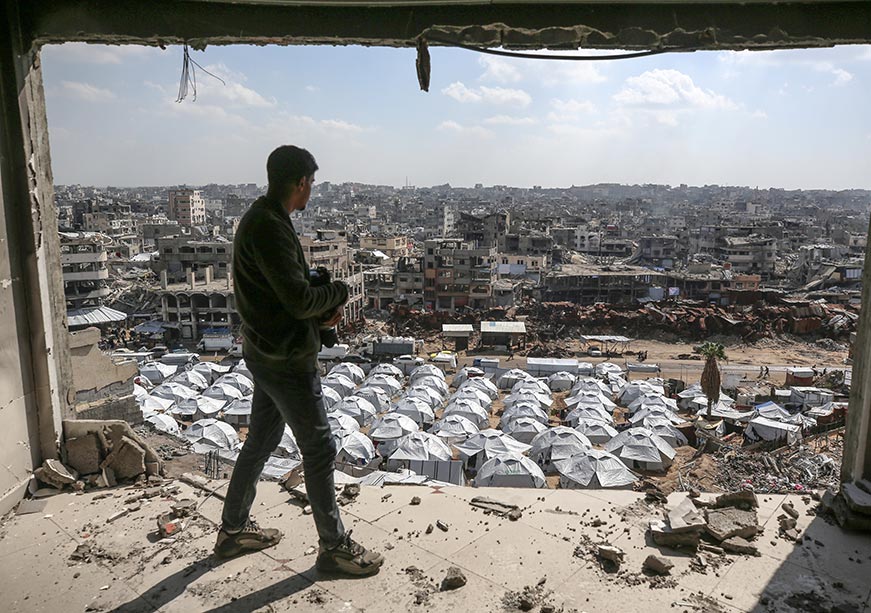-
CENTRES
Progammes & Centres
Location
Gaza’s reconstruction hinges on addressing Hamas’ political grip over the region—a challenge Arab powers and global leaders are struggling to resolve amid shifting geopolitics.

Image Source: Getty
Gulf powers in the Middle East are locked in a sprint towards coming up with a viable plan for Gaza’s reconstruction and upkeep as President Donald Trump takes charge in Washington, and mobilises pressure by threatening a take-over of the strip by the US. Trump’s plan includes a “relocation and resettlement of the population in Gaza to safer, neighbouring nations” such as Egypt and Jordan, and in return subsequently transforming the contentious piece of land into a “riviera of the Middle East”.
Trump’s quintessential take—viewing Gaza more as a real-estate problem than a deep-rooted geopolitical crisis, especially at the nucleus of many Middle Eastern fissures— has, if nothing else, forced Arab powers into an urgent huddle. The leaders of Saudi Arabia, Jordan, Qatar, Egypt, United Arab Emirates, Bahrain, and Kuwait recently met in Riyadh to try and reinvigorate an Arab-led blueprint for the Palestinian crisis as Israel’s war against Hamas in Gaza continues. How serious Trump is regarding his view of the displacement and reinstatement of a population is up for debate. But the relatively casual tone of narratives flowing in from the White House has certainly ruffled enough feathers to mobilise regional powers, ahead of the emergency Arab Summit in Cairo, Egypt on 4 March 2025, to further discuss Gaza’s reconstruction plan.
The leaders of Saudi Arabia, Jordan, Qatar, Egypt, United Arab Emirates, Bahrain, and Kuwait recently met in Riyadh to try and reinvigorate an Arab-led blueprint for the Palestinian crisis as Israel’s war against Hamas in Gaza continues.
However, the core issue in the Gaza context today is not simply reconstruction and rebuilding, but also the political future of the strip and the Palestinian cause. Questions about the political leadership of the Palestinians, beyond Hamas, remain critical. Currently, there is neither clarity, direction nor any movement to address this core conundrum. While Hamas has been dealt multiple blows over the past year and a half, including the planned assassination of its top leadership, it seems to be holding on to its influence despite Israel’s stated vision of eliminating the group. This is only coupled with the fact that any potential replacement of Hamas, at least in a public forum, has not been seriously discussed regionally.
Replacing Hamas as both a political and military influence in Gaza will not be a simple endeavour even though the militant group itself is responsible for much of Gaza’s suffering. While Israel’s heavy-handedness in using disproportionate force since October 2023 has flattened Gaza into a nearly unrecognisable geography, Hamas is still quite functional. It recently clocked Public Relations (PR) wins on the sidelines of prisoner exchanges as part of the ceasefire agreement and a broader distinction of the idea of ‘resistance’ from ‘terror’ in many sections of public discourse. Its other sibling, the Palestinian Islamic Jihad (PIJ) during a recent visit to Iran added to the complexities as PIJ’s Chief Ziad al-Nakhala reaffirmed his commitment towards the “path of resistance”.
For the Arab powers, the path forward is undeniably fraught. The financial practicality behind Gaza’s reconstruction, in injecting both political and economic sponsorships, is not as difficult for several of these cash-rich states. However, to remould Palestinian politics to future-proof it against a military-first posture and simultaneously be cognizant of Israel’s security interests has multiple layers attached to it. The path forward would ideally demand both compromises and clarity from all parties involved, a task easier said than done.
The financial practicality behind Gaza’s reconstruction, in injecting both political and economic sponsorships, is not as difficult for several of these cash-rich states.
To begin with, both Saudi Arabia and the UAE may need to leverage their access with Iran in an institutional manner, aiming to ease Tehran’s support for Hamas, PIJ, and Hezbollah. Thereafter, Israel would have to be brought in, and at the very basic, its sovereignty-led security needs would have to be realistically addressed. Whether this translates into a two-state solution or not, remains the fundamental question. On paper, no other outcomes exist, and any other disruption in the status quo in all likeliness will not be a solution, but a bandaid at best. The underlying question now remains, whether a solution should be sought, or is the status-quo consolidating benefits to only a few, the preferred choice.
The regional competition, which has benefited from the Palestinian flux, by working in a both short-term favourable capacity and often against regional players, including Arab states, will also have to deal with big power competition. This is an added spanner in the proverbial peace wheel. China has already thrown its support behind an Arab-led pro-Palestine two-state solution. Russia, however, is on the ropes. The overnight collapse of the regime of Bashar al-Assad in Syria not only dented Moscow’s political clout, but geographically, has also pushed it to the peripheries of the region whilst mediating with the new regime of Ahmed al-Sharaa in Damascus to regain control of its lost military bases on the country’s Mediterranean coast. Simultaneously, a Donald Trump–Vladimir Putin détente is not only putting Europe on the edge but Iran as well. Such a speculation is driven by Iran’s well-defined fears that its long-standing ally in Moscow could give America concessions for long-term strategic gain in the European continent in exchange for leverage over Tehran, particularly at the United Nations Security Council.
The regional competition, which has benefited from the Palestinian flux, by working in a both short-term favourable capacity and often against regional players, including Arab states, will also have to deal with big power competition.
In all the aforementioned kerfuffle, the future of Palestinian politics rests in a grey zone. Any attempt to dismantle the grip of Hamas Gaza would have to be a long-winded process. Militarily, an outright elimination may not be possible. Politically, subsuming Hamas into a broader Palestinian process is perhaps an even graver challenge, with the group’s penchant to fight even within the Palestinian systems to ensure its hegemony remains undeterred.
Finally, the Arab world finds itself in a spot of bother. It ideally wants Hamas gone, but equally expects to not be held responsible for any long-term or even permanent displacement of the Palestinian people from Gaza. This is not only because of what may be the right thing to do from an Arab perspective, but also because any perception of their collusion over such an act could become a direct challenge to the leader’s authority, especially if the issue galvanises the street and public sentiment beyond a point.
Envisioning the next four years, Trump is now imploring Europeans to think more deeply about their own security viz-a-viz Russia, and Arabs to take more responsibility for regional dynamics viz-a-viz Israel and Palestine. This disruption in particular, may not be entirely detrimental in the long run.
Kabir Taneja is a Deputy Director and Fellow with the Strategic Studies programme at the Observer Research Foundation.
The views expressed above belong to the author(s). ORF research and analyses now available on Telegram! Click here to access our curated content — blogs, longforms and interviews.

Kabir Taneja is a Deputy Director and Fellow, Middle East, with the Strategic Studies programme. His research focuses on India’s relations with the Middle East ...
Read More +